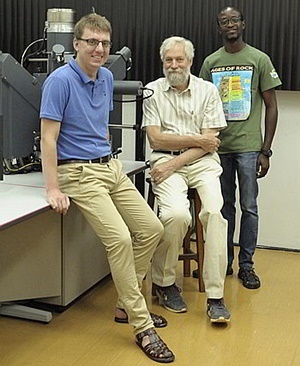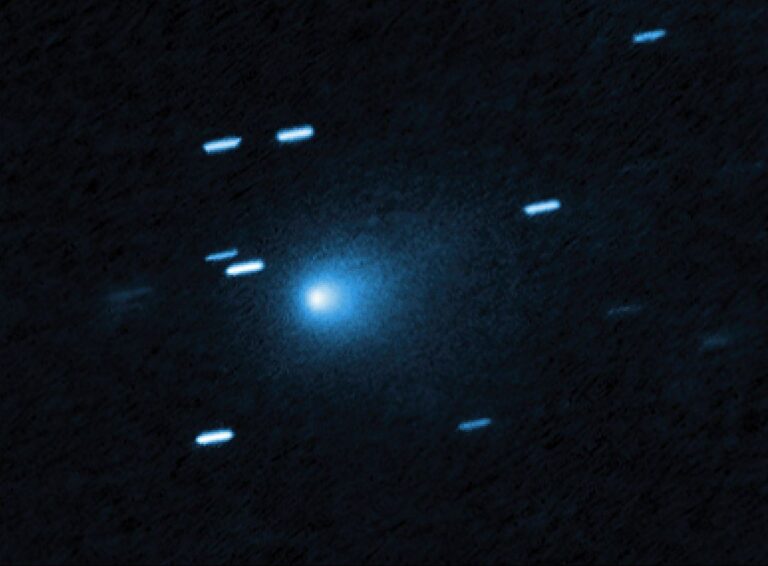Key Takeaways:
It’s common for researchers to conduct a mineral analysis on a suspected meteorite, dissecting and identifying its compounds to determine what it is and where it came from. The process is usually done with ease, and generally gives researchers a simple method for establishing origin. But that simplicity was challenged when researchers came across a peculiar pebble in southwest Egypt, with a mineral makeup unlike any other planetary object.
Unlike most meteorites, which have chemical compositions similar to Earth and the other rocky planets, this one had elements in the wrong proportions, or in forms not usually seen in the inner solar system. It raises the question: Is our idea of how the solar system formed and how the elements were originally scattered throughout it the right one?
A rock of unusual composition
The curious case started in 2013 when a team of researchers at the University of Johannesburg revealed that an Egyptian stone, discovered in 1996, was definitely extraterrestrial. In 2015, a separate group of researchers conducted a nuclear probe and noble gas analysis, determining that the Hypatia stone (named after the famous Western woman astronomer and mathematician, Hypatia of Alexandria) didn’t come from any recognized comets or meteorites. Recently, the University of Johannesburg researchers returned to the case to answer the looming question: Where did this mysterious rock come from? The answer, published in Geochimica et Cosmochimica Acta in December, may cause us to rethink the materials that formed our solar system.
Hypatia is thought to be a fragment of an extraterrestrial rock originally several meters long, which segmented into numerous pieces during its journey to Earth. It has a mineral composition unlike that of any meteorite we’ve seen. A chondritic meteorite’s chemical composition, for example, is similar to Earth’s, with high amounts of silicon and low amounts of carbon. (Chondritic meteorites are extremely common, making up about 86 percent of known meteorites.) Hypatia’s composition, however, is just the opposite, with unusually high amounts carbon and low amounts of silicon.
“Even more unusual, the matrix (the stone, inside which dust grains are embedded) contains a high amount of very specific carbon compounds, called polyaromatic hydrocarbons, or PAH, a major component of interstellar dust, which existed even before our solar system was formed,” said Prof. Jan Kramers, who led the study, in a press release.“Interstellar dust is also found in comets and meteorites that have not been heated up for a prolonged period in their history.”
Oddly enough, the majority of PAH in the matrix turned into tiny diamonds, no larger than one micrometer, likely due to the immense heat and pressure when Hypatia made contact with Earth’s atmosphere or surface. However, the diamonds weren’t the only surprise that researchers came across when they analyzed the mysterious stone. Geologist Georgy Belyanin also found unexpected chemical elements in the interstellar dust grains embedded throughout the stone, including a rare form of aluminum.
“The aluminum occurs in pure metallic form, on its own, not in a chemical compound with other elements. As a comparison, gold occurs in nuggets, but aluminum never does. This occurrence is extremely rare on Earth and the rest of our solar system, as far as is known in science,” said Belyanin. “We also found silver iodine phosphide and moissanite (silicon carbide) grains, again in highly unexpected forms. The grains are the first documented to be found in situ (as is) without having to first dissolve the surrounding rock with acid,” adds Belyanin. “There are also grains of a compound consisting of mainly nickel and phosphorus, with very little iron; a mineral composition never observed before on Earth or in meteorites.”
A pre-solar origin
Hypatia’s abnormal composition implies that it’s made up of material that existed prior to the formation of the Sun and the planets in our solar system. But then, based on its composition, the question of how and where the iron, nickel, and phosphorus within Hypatia were formed arises.
These elements reside in the class of chemical heavier than carbon and nitrogen, which make up the majority of our rocky planets. “In the grains within Hypatia the ratios of these three elements to each other are completely different from that calculated for the planet Earth or measured in known types of meteorites. As such these inclusions are unique within our solar system,” said Belyanin. “We think the nickel-phosphorus-iron grains formed pre-solar … and are unlikely to have been modified by shock such as collision with the Earth’s atmosphere or surface, and also because their composition is so alien to our solar system.”
The nickel-phosphorus-iron grains are likely dust that became embedded in the matrix of the stone, just as nuts and fruit are embedded in dough to make fruitcake. However, unlike the grains, Belyanin says that the matrix itself probably wasn’t pre-solar, as it would have needed a cloud of dense interstellar dust to form.
It’s believed that the solar nebula, a massive cloud of dust and gas, produced the Sun and the planets in our solar system. Planet formation likely began with concentration of the nebula’s solar dust, which has long been believed to be homogenous (the same throughout). However, Hypatia casts doubt on the homogenous theory.
“For starters, there are no silicate minerals in Hypatia’s matrix, in contrast to chondritic meteorites (and planets like the Earth, Mars and Venus), where silicates are dominant. Then there are the exotic mineral inclusions. If Hypatia itself is not pre-solar, both features indicate that the solar nebula wasn’t the same kind of dust everywhere — which starts tugging at the generally accepted view of the formation of our solar system,” said Kramers.
Despite the shroud of mystery that hangs over Hypatia’s existence, we do know that it formed in an environment with temperatures colder than that of liquid nitrogen, which is about -384° Fahrenheit (-196° Celsius). We also know that it came from an area beyond the asteroid belt, which produces the majority of our meteorites, and the Kuiper Belt, where most of our comets come from. However, very little is known about the chemical compositions of deeper space objects.
Researchers continue to question the origin of this mysterious stone, and its clues only cast doubt over the distribution of elements inside the nebula that we believe formed our solar system.











